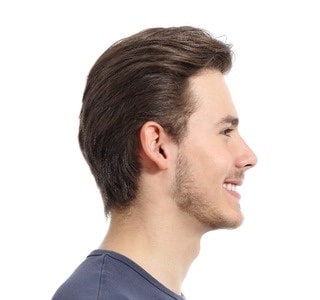The Male Nose

Once considered unmasculine, cosmetic treatments have broken through the gender barrier. Today, more men are choosing to enhance their appearance with cosmetic surgery. In the United States, one of the most popular cosmetic procedures performed–on both men and women– is nose surgery, or rhinoplasty. According to statistics presented by the American Society of Plastic Surgeons in 2013, male rhinoplasty procedures account for about 25% of the total rhinoplasties performed in the nation–far above the male percentage rates for other cosmetic procedures. In some regions, the percentage tends to be higher than the national average.
But is a male rhinoplasty procedure different from a female rhinoplasty? Yes and no. The basic surgical principles are similar (incisions, sculpting of bone and cartilage, and closure), but the aesthetic goals can be quite distinct. This is because the male nose is thought to have different ideal characteristics than the female nose. In fact, what is considered attractive for men may be the opposite for women. For example:
- Nose width. The span of the nose is a feature that contributes to a masculine appearance. In men, a broad nose can strengthen aesthetic appeal, whereas in women narrowness is likely to prevail.
- Nose size. A prominent nose is often seen as a valued masculine trait. Thus, it is much more common for a male to approach rhinoplasty with the idea of augmentation than it is for a woman. Women typically seek a reduction in the size of their nose.
- Nasal Tip. An upturned tip tends to look awkward on a man, but acceptable on a woman. To achieve a strong frontal view and profile, a neutral, unrotated tip should be maintained.
Obviously, every nose is unique, so it more important to consider the proportion of the nose in relation to the rest of the face than to follow a set of ideals. What is ‘perfect’ on one person be out of place on another. Dr. Halaas can give more accurate recommendations, based on your facial features.
Recovering from a Rhinoplasty Procedure
Recovering from a rhinoplasty procedure takes time. After the most conspicuous post-operative swelling and bruising has subsided (usually about 10-14 days), the nose will continue to heal and adjust to its new form. Although most people will see a significant results within month or two, it may take up to a year for subtle changes to take hold and for the nose to fully stabilize into its final shape. To aid in your healing, Dr. Halaas makes a few general recommendations:
- Elevate your head. To alleviate swelling, it is recommended that you sleep with the head elevated for the first week.
- Take it easy. Avoid vigorous exercise and swimming in the first few weeks. Sports with a high risk of contact injury, such as basketball, should be avoided for about 6 weeks.
- Adopt healthy habits. We all know that smoking harms our health, but it is especially true when the body is in healing mode. Smoking increases the risk of bleeding and should be stopped a few weeks before and after surgery. If you are a smoker and have thought about quitting, your rhinoplasty might serve as a jumpstart.
- Use sunscreen. After a rhinoplasty, the skin on the nose is particularly sensitive to ultraviolet (UV) damage. If left unprotected, permanent discoloration can occur. Applying sunscreen daily will reduce the chances of a sun-damaged nose.
Your Consultation with Dr. Halaas, NYC
With rhinoplasty among the top five sought after cosmetic procedures, it follows that dissatisfaction with the shape of the nose is a common concern for the population at large. If you are interested in learning more about male rhinoplasty, schedule an appointment with Dr. Halaas at her New York office. Dr. Halaas grasps the complexities of rhinoplasty, as well as the nuances of shaping the masculine nose.